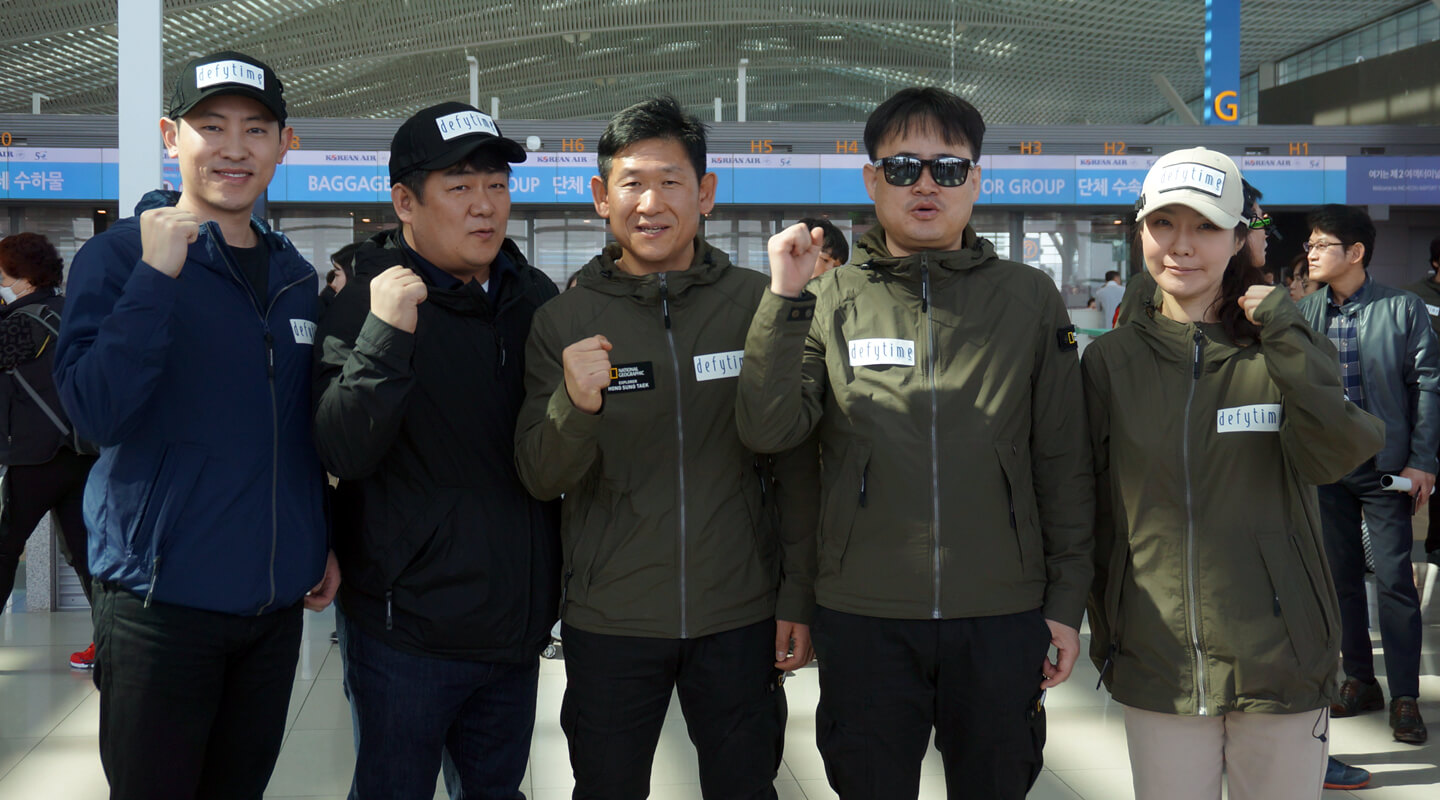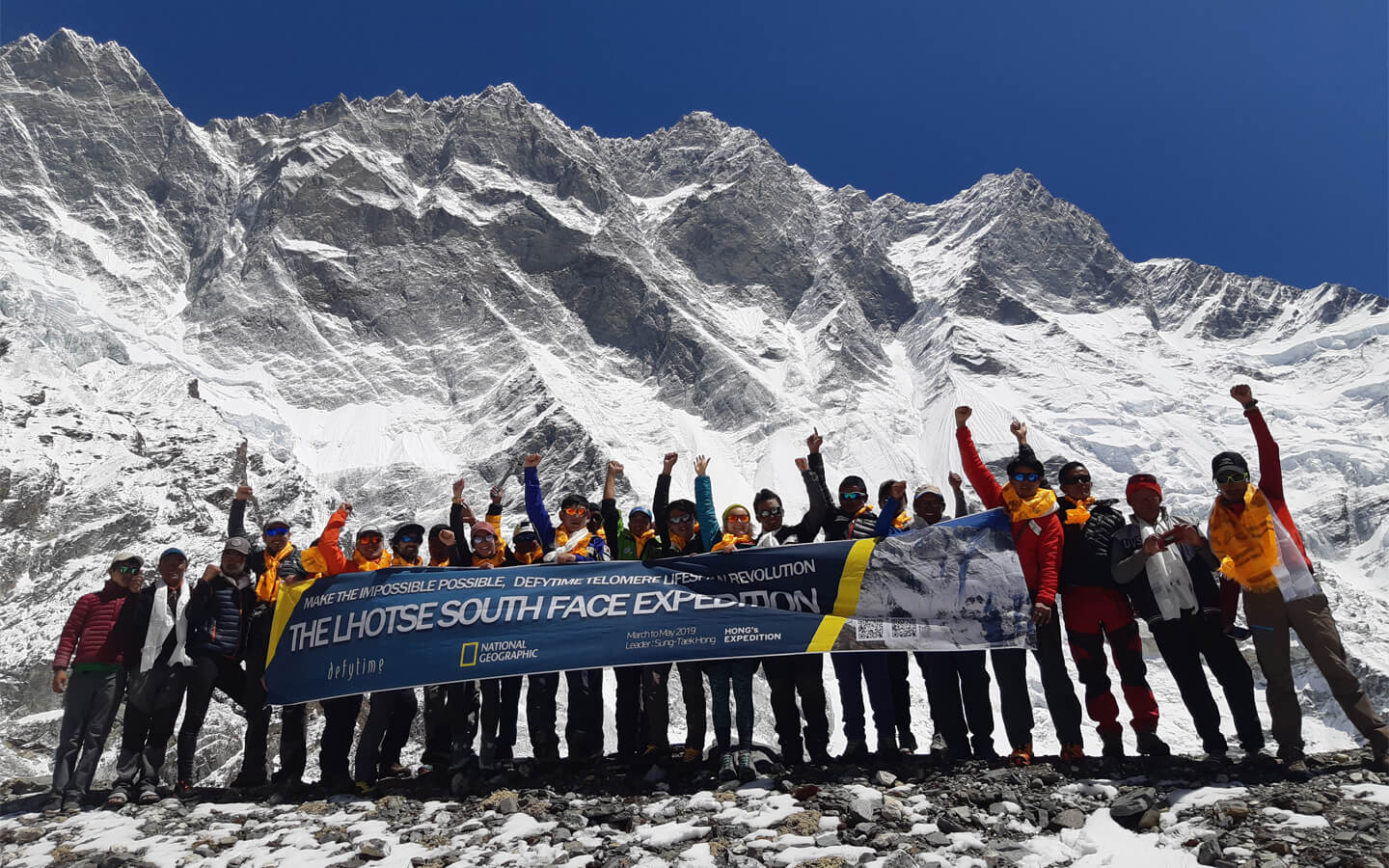Hong, Sung-Taek and his team of experienced mountaineers arrived in Kathmandu, Nepal, early April to begin the Lhotse South Face Expedition. This will be Captain Hong’s sixth and final attempt at conquering the mountains notoriously difficult southern ice wall. “Lhotse’s south wall is the end of my long journey as a climber.”
Defytime is the sponsor of the expedition. “The challenge of a new climbing route to the summit is similar to Defytime’s challenge for aging treatment,” says Jonathan Greenwood, president of Defytime. “Nobody pays attention until after the success. I decided to sponsor the expedition to meet the challenge of Captain Hong, Sung-Taek, who does not know how to give up despite repeated failures.”

Hong, Sung-Taek (centre) with the Defytime team before departure to Kathmandu.
This marks the first time that the Korean climber will try the wall in spring, rather than in the post-monsoon season. On their previous expedition in 2017, weather conditions deteriorated as their climbing period changed from autumn to winter. In consideration of the accident risk and safety of the crew, the team decided to turn back leaving the last 200 meters to the summit. “It is my dream to solve the problem that the mountain climbers of the world have not solved, by climbing the south face to the top of the mountain of Lhotse,” says Hong. “I am concentrating on safe climbing so that everyone can go to the summit safely without getting hurt.”
Lhotse south face is well known among mountaineers as one of the most difficult to climb. This requires ascending a 3,300 meter (11,000 foot) wall of ice and rock that is often vertical. “It is rare that two feet touch the ground, there is almost no flat place,” says Hong, describing some of the challenges. “If the weather gets warm, snow and ice melt and frozen rocks fall off. When the weather is cold, the rocks are frozen together. Even small rocks are very dangerous when they fall from 2,000 meters above. At dawn, there is less risk of rockfall due to the cold. When the sun is shining, the rock falls off even after only one hour. I usually start climbing around 1 a.m. and do not move during the day if possible.”
Lhotse Expedition 2015
Hong is expected to retire from climbing regardless of the success or failure of the Lhotse Expedition. “Whether I succeed or fail Lhotse, I will not climb anymore. I plan to push myself hard as long as safety is assured. It is expected to be a difficult and harsh climb. The hardships and trials that are given can be tolerated. I am always praying that there will be no avalanche. I’ve done everything I can. If this expedition succeeds, I think it will be a valuable record that I will never forget, and even if it fails, I will not regret it because I did my best. I think it will be an honorable failure.”
The project is being filmed by National Geographic and is scheduled to air in 2019 as a documentary.
About Lhotse
Located in the Himalayas, Lhotse is the fourth highest mountain in the world at 8,516 metres (27,940 ft), after Mount Everest, K2, and Kangchenjunga. The summit is on the border between Tibet of China and the Khumbu region of Nepal. Although several mountaineers have climbed Lhotse, no one has ever ascended through the south face. Lhotse’s south face is a vertical ice wall that requires climbing up to 3,300m to the summit from the base camp located 5,200m above sea level. It is considered to be one of the most challenging and dangerous climbs in the Himalayas.
About Hong, Sung-Taek
Hong, Sung-Taek is a mountaineer, adventurer, explorer and author from South Korea. He is currently a National Geographic Explorer supported by a National Geographic explorers program and a principal of KSAF Mountaineers Academy. He is renowned for reaching all the Three Poles and crossing the Bering Strait and Greenland for the first time. He summited Everest in 1995, skied to the South Pole in 1994 and walked to the North Pole in 2005. He also crossed Bering Strait by foot in 2012 (official) and crossed Greenland by dog sledding in 2011.






